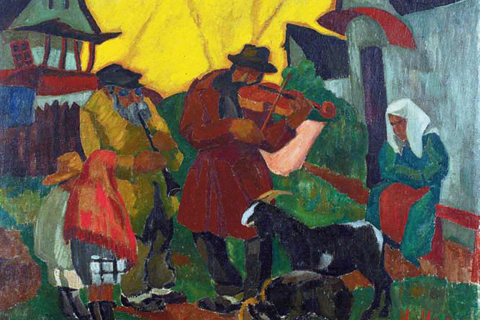Twenty Shades of Youth
20 Ukrainian artists – nominees for the Pinchuk Art Centre Prize 2013 – presented their works in the art centre. All of the artworks were created especially for this project, in cooperation with the Pinchuk Art Centre curator, Bjorn Geldhof. The exhibition was announced as a panorama of young Ukrainian art. Of the nearly 1,000 applications, the committee selected 20 most accomplished and promising participants. The winners include experienced artists, such as Zhanna Kadyrova, a participant of the Venice and Moscow Biennales and winner of the Kazimir Malevich Award, and the scandalous singer of songs about miners’ daily lives, Roman Minin, as well as new in contemporary art, such as Oleh Hryshchenko and Andriy Khir. According to Bjorn Geldhof, this year’s exhibition proves that Ukrainian art has finally not only felt intuitively, but has become aware of its potential. “We are now seeing an in-depth development of the context,” Geldhof commented.
The works of many participants appear inferior, sometimes because of difficult themes and sometimes because of the hesitant use of material. When developing the Ukrainian context, artists seem to have chosen safe universal subjects as opposed to edgy, but far more penetrating intimate moments. The police theme in Mykola Ridny’s installation, the city rituals of Volodymyr Vorotnov, the mentality problem of Yevheniya Belorusets, the fleeting everyday life of Anna Zviahintseva and Maria Kulykovska – these concepts have already become the worn-out records of contemporary art. At the same time, Lada Nakonechna’s work with space and Oleh Hryshchenko’s work with a cultural code lack decisiveness. The projects of Oleksandr Kurmaz, Andriy Khir and the Open Group balance on the edge of counterculture and are a search, rather than a realization of art potential.
However, there are also truly ingenious pieces. They include the audio installation by Ivan Svitlychniy, where the sounds of objects are recorded and played through electronic filters. Stop at a specific spot between the loudspeakers, and you will feel how the noise becomes ordered and transforms into an acoustic sculpture. Alina Kopytsia moves visitors to a play room where, as observers of innocent games, they are invited to examine their own sexuality. For his Plan of Escape from Donetsk Oblast, Roman Minin involved a whole group of children, which made the object documentary. Dobrynia Ivanov presented work in progress, which is also a documentary. The artist will talk to the people close to him in a separate sound-proof room throughout the exhibition. The conclusion of these interviews will be an object that will embody the artist’s feelings about himself. The group Synchrodogs reflects parallel dimensions in photographs, in which the form of a human body changes, losing old capabilities and gaining new ones. The video installation of Olesia Khomenko records the act of painting, associating it with biologically creative, maternal energy. The triumph of the exhibition is Zhanna Kadyrova’s Monumental Propaganda – a mosaic that is several meters long, where heroes of the consumer society and ideal advertising images that promise a happy life (see photo) appear in socialist-realist aesthetics. Just like many other artists, Kadyrova tried to work with artistic means that are new to her, within the limits of her project for Pinchuk Art Centre. The international jury will name the breakthrough in Ukrainian art in December 2013. Meanwhile, visitors can vote for the future winner of the people’s choice prize.

Migrating Avant-Garde
The National Art Museum once again exhibits a private collection. This time, it offers a collection of paintings and graphic art from the early 20th century by the Odesa-based Society of Independent Painters, avant-garde artists of that time. Several representatives of this group were lucky enough to live in Europe for a while, particularly in Paris, from which they brought the latest painting ideas to Odesa. They then implanted European ideas in other like-minded artists.
According to art critic Halyna Tuluzakova, the collection is notable not for its artistic quality, but for the history it tells – the history of escape. The names of Ukrainian artists presented here are little-known at home: Teofil Frayerman, Amshey Nurenberg, Isaak Malik and Mykhailo Hershenfeld. This is because the collection was kept abroad for almost a century. Over the time it existed, the Society organized just six shows in Odesa. With the arrival of the Bolsheviks, painting, which reinterpreted bourgeois trends, and the very lives of artists, came under threat. Those who did not switch to Social Realism lived out their lives in concentration camps. Fate was kinder to their paintings: in 1919, Yakiv Peremen, a collector, took the paintings out of Ukraine to save them. For a long time, they remained in private collections in Israel – the owners had no idea of the artistic value of the canvasses and kept them as family relics. There they remained until collectors in Israel collected the entire mass of work based on Pereman’s memoirs and put them up for auction at Sotheby’s. There, the Ukrainian Avant-Garde Fund, which organized the exhibition, acquired the paintings for USD 2mn. Today, the exhibition is a kind of travelling attraction, which in addition to Kyiv, will be shown in Vienna, Moscow and Paris. As the Fund’s representatives noted, although the art of the Society of Independent Painters is cosmopolitan, the canvasses were painted in Ukraine, so after the tour, they may end up at the Ukrainian museum.

